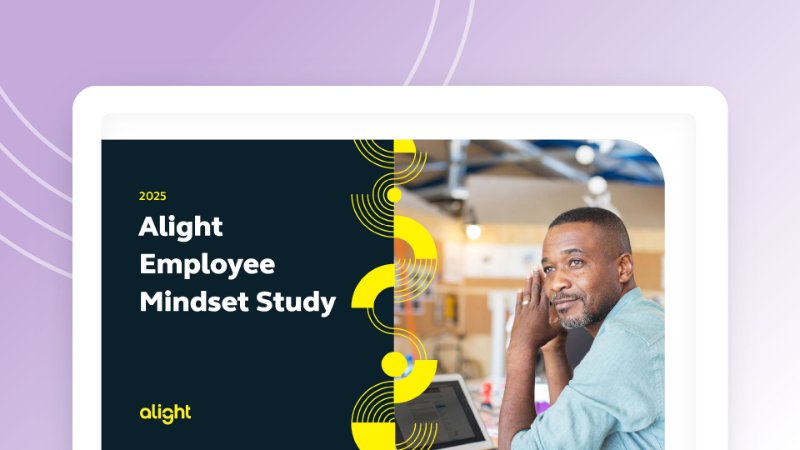In today’s workplace, four generations sit side by side, each with a radically different view of technology, work location (on-site vs. remove vs. hybrid), communication preferences — even which benefits matter the most. What one generation considers indispensable, another may barely notice. To attract and retain talent, employers must move beyond “one-size-fits-all” and deliver personalized, data-driven benefit packages that speak to each group’s unique priorities, expectations and life stage challenges.
Key generational findings from Alight’s 2025 Employee Mindset Study:
- Benefit priorities differ sharply by generation
- Generic offerings satisfy no one
- Personalized, tech-enabled solutions deliver a competitive advantage
Baby Boomers (born 1946‒1964)
Born during the economic boom that followed World War II, Boomers are traditionally known for their strong work ethic and competitive professional approach. They tend to value traditional workplace hierarchies, structured environments and face-to-face communication. Boomers are often in leadership or senior management positions.
When it comes to benefits, Boomers are generally less enthusiastic than their younger counterparts. Just 6% say better benefits would be a reason to change employers (compared to 11% of everyone else) and 4% of Boomers leaving their employer report it is because of benefits (vs. 11% of everyone else).
Perhaps not surprisingly, Boomers are most likely to say programs like healthy aging and heart health are the most valued. However, when these benefits are offered, Boomers are among the least likely to use them.
“I want stability, not trendy perks.”

Generation X (born 1965‒1980)
Often called the "forgotten generation," Gen X bridges the gap between Boomers and Millennials. Historically, they have been characterized by their independence, adaptability and skepticism toward institutional systems. At work, Gen Xers are known for their entrepreneurial spirit, commitment to work-life balance and comfort with both traditional and emerging technologies.
When changing jobs, nearly one-quarter (23%) of Gen Xers say they don’t compare benefits, compared to just 5% of everyone else.
Part of the reason could be pay — Gen Xers are most likely to feel they are not paid enough for the work they do. However, Gen Xers are also most critical of their employer’s communication. Just over half (54%) think their employer does a good job communicating overall (vs. 64% of everyone else), and 56% think the communication they receive is relevant (vs. 63% of everyone else).
“Don't sell me corporate fluff. Give me real, tangible benefits that help me manage my complex life without drama.”

Millennials (born 1981‒1996)
Millennials are tech-savvy individuals who generally prioritize purpose-driven work and personal growth. They are the most educated generation in history and tend to job-hop more frequently than those that came before them. In the workplace, Millennials seek collaborative environments and value flexibility.
When it comes to benefits, Millennials tend to be power users. They are most likely to say the benefits they receive are relevant to them (62% vs. 52% of the rest) and easy to access when they need them (61% vs. 53%). Millennials also appreciate benefits that provide them flexibility, like getting paid more frequently and having a paid time-off exchange.
Fringe benefits are a popular perk for these tech-savvy young workers. Over three-quarters say they find value in nutrition benefits (77%), exercise programs (76%) and mental and emotional health apps (75%). However, this enthusiasm doesn’t always translate to usage. Only about half of Millennials take advantage of these offerings, when available.
“Flexible work isn't a perk, it's an expectation.”

Generation Z (born 1997‒2012)
The first truly digital-native generation, Gen Z grew up with smartphones, social media and instant access to global information. Known for their entrepreneurial, diverse and socially conscious tendencies, these young adults are the latest generation to enter the workforce. At work, Gen Z values individual creativity, expects technological integration and prioritizes mental health.
Gen Z is most likely to feel that benefits are a good investment (61% vs. 54% of the rest) and make a company more attractive (61% vs. 54% of the rest). Interestingly, their understanding of benefits is high — 59% say they fully understand the benefits available to them and 66% feel the pay, benefits and wellbeing communication they receive is easy to understand.
Not surprisingly, Gen Z workers are focused on building and growing — both personally and professionally. They’d like a fertility planning benefit but also want personalized financial and health management. When it comes to their physical health, members of Gen Z are taking early prevention steps. One-third (33%) use a tobacco/substance abuse support benefit, when available, and nearly half (49%) participate in diabetes prevention and support.
“One-size-fits-all is outdated.”

Percent saying a benefit would be valuable
Total | Gen Z | Millennials | Gen X | Boomers+ | |
|---|---|---|---|---|---|
Access to low-interest short-term loans | 64% | 72% | 70% | 54% | 37% |
Caregiver support/resources | 63% | 70% | 72% | 49% | 39% |
Diabetes prevention and support | 64% | 69% | 72% | 56% | 42% |
Digital therapeutics or preventive digital coaching | 58% | 65% | 67% | 45% | 35% |
Exercise/physical fitness | 71% | 73% | 76% | 66% | 57% |
Fertility planning and family building | 57% | 68% | 69% | 35% | 27% |
Getting paid more frequently | 69% | 78% | 74% | 61% | 41% |
Healthy aging | 69% | 70% | 74% | 64% | 57% |
Heart health | 71% | 73% | 75% | 67% | 58% |
Live 1:1 health coaching | 63% | 70% | 72% | 51% | 39% |
Men's health | 64% | 72% | 71% | 51% | 38% |
Mental and emotional health apps | 68% | 73% | 75% | 60% | 42% |
Nutrition, healthy eating and/or weight management classes or programs | 70% | 71% | 77% | 63% | 54% |
Paid time off exchange | 66% | 74% | 74% | 55% | 35% |
Parental support | 62% | 72% | 73% | 46% | 31% |
Personalized financial management | 68% | 74% | 75% | 60% | 45% |
Personalized health management | 68% | 73% | 74% | 58% | 49% |
Personalized support for navigating the health system and costs | 67% | 74% | 73% | 58% | 49% |
Physical therapy/musculoskeletal programs | 64% | 70% | 72% | 54% | 40% |
Telephonic, virtual or online visit with a mental health professional | 66% | 70% | 73% | 59% | 46% |
Tobacco and substance abuse support | 57% | 66% | 64% | 44% | 33% |
Wellbeing marketplace | 64% | 67% | 73% | 54% | 46% |
Women's health/menopause support | 67% | 73% | 73% | 61% | 41% |
Percent using benefit, when available
Total | Gen Z | Millennials | Gen X | Boomers+ | |
|---|---|---|---|---|---|
Access to low-interest short-term loans | 34% | 37% | 37% | 27% | 21% |
Caregiver support/resources | 23% | 32% | 33% | 7% | 5% |
Diabetes prevention and support | 36% | 49% | 36% | 31% | 30% |
Digital therapeutics or preventive digital coaching | 38% | 50% | 42% | 29% | 14% |
Exercise/physical fitness | 51% | 60% | 53% | 48% | 27% |
Fertility planning and family building | 25% | 42% | 24% | 10% | 11% |
Getting paid more frequently | 45% | 46% | 43% | 52% | 36% |
Healthy aging | 40% | 39% | 46% | 25% | 42% |
Heart health | 32% | 31% | 35% | 29% | 28% |
Live 1:1 health coaching | 33% | 35% | 36% | 26% | 41% |
Men's health | 44% | 57% | 46% | 32% | 24% |
Mental and emotional health apps | 30% | 45% | 35% | 25% | 12% |
Nutrition, healthy eating and/or weight management classes or programs | 34% | 30% | 39% | 30% | 23% |
Paid time off exchange | 42% | 41% | 48% | 40% | 23% |
Parental support | 28% | 48% | 31% | 10% | 6% |
Personalized financial management | 33% | 43% | 36% | 17% | 32% |
Personalized health management | 35% | 41% | 37% | 28% | 31% |
Personalized support for navigating the health system and costs | 36% | 42% | 43% | 26% | 8% |
Physical therapy/musculoskeletal programs | 36% | 36% | 43% | 26% | 20% |
Telephonic, virtual or online visit with a mental health professional | 30% | 36% | 35% | 22% | 28% |
Tobacco and substance abuse support | 18% | 33% | 22% | 8% | 3% |
Wellbeing marketplace | 39% | 45% | 40% | 32% | 43% |
Women's health/menopause support | 28% | 28% | 29% | 29% | 24% |
Recommendations for employers:
- Invest in technology-enabled benefit solutions
- Implement flexible, personalized benefits platforms
- Develop multi-channel communication strategies
With more generations in the workforce than ever before, employers are challenged to deliver on their expectations. When it comes to benefits, employees’ needs can be vastly different, thus unable to be served by a traditional one-size-fits-all strategy. The future of workplace benefits is personalized, technology-driven and generation-specific. Employers that understand and adapt to these diverse expectations will be best positioned to deliver a favorable employee experience, boost morale, improve productivity and attract and retain top talent.

2025 Alight Employee Mindset Study
Read the report for more insights into the minds of 2025’s workforce


